U.S. PUBLIC OPINION SUPPORTS SOVIET ENTRY IN PACIFIC WAR
Potsdam, Germany • July 21, 1945
The “Big Three” Allies opened their victors’ conference on July 17, 1945, in an undamaged suburb 15 miles/24 kilometers from Berlin, the German capital. Two dramatic unconditional surrenders by the heads of Germany’s armed forces a week after the April 30 suicide of German dictator Adolf Hitler had encouraged the government heads of the U.S., Great Britain, and the Soviet Union to assemble with their political and military advisers in Potsdam, Germany as quickly as possible. The delegates’ weighty task: establish a peaceful geopolitical and economic postwar order in the ruins of war-torn Europe. Weighing slightly less on the delegates’ minds—yet more so on the minds of Americans on the home front and their loved ones assembled on warships and in island garrisons off the coast of Japan—was how to end the still-raging war with Germany’s hold-out military partner as expeditiously as possible and establish a similar postwar order in the Asia Pacific region.
Exactly how to end the war with Japan generated intense debate. The geography of the island nation complicated attempts at a ground invasion. Honshū, Japan’s most populous island and the location of its capital, Tokyo, was Japan’s largest city as well as home to the quasi-divine Emperor Hirohito (posthumously referred to as Emperor Shōwa). Unlike Hitler, who survived multiple of attempts by his military to assassinate him, Hirohito had no such domestic foes until the very last hours of the Pacific War. Besides, Hirohito had come to viewed by most U.S. military officials as the only figure with the requisite credentials to engineer Japan’s surrender.
The emperor and his fire-breathing warlords needed something outside the traditional war book to induce them to the peace table. U.S. physicists and military planners were busy secretly building a bomb of unknown capability that might or might not end World War II with a bang. At the same time the new American president, Harry S. Truman, was pursuing a strategy to enlarge the conflict. Step 1: entice wartime ally Joseph Stalin, head of the Soviet Union, to abandon his nation’s nonaggression pact with Japan. (Agreement appeared close at hand in February 1945 at a Big Three conference at Yalta in the Soviet Crimea.) Step 2: convince Stalin to declare war on Japan. On this date, July 21, 1945, strategy-confirming news reached Truman in Potsdam. U.S. Secretary of State James Byrnes handed the president a news summary that showed American press opinion strongly supported the Soviets’ entry into the war—a war U.S. military advisers estimated might cost the belligerents hundreds of thousands more deaths and drag on for upwards of 16 months.
Despite overwhelming public and media support for the Red Army entering the Pacific fray, a few voices in the State, War, and Navy departments raised late-term concerns. All for naught. Stalin told Truman on Day 1 of the Potsdam Conference that his military would invade Chinese Manchuria (Japanese puppet state Manchukuo) by mid‑August 1945. Although Soviet conditions appeared modest to Truman, in reality Stalin saw a strategic opportunity to turn the tables on the Japanese by regaining Chinese assets Czarist Russia had lost following the disastrous Russo-Japanese War in 1904–1905.
On August 6, 1945, as diplomatic negotiations dragged on, a single U.S. B‑29 Superfortress dropped a fearsome bomb on Hiroshima that killed 70,000 Japanese outright. Three days later, on August 9, 40,000 residents of Nagasaki died outright in a second atomic blast. Earlier that day Soviet armed forces invaded Manchuria; Stalin had kept his word. Japan suddenly found itself in a tight spot: Soviet troops making a beeline for the China coast, American B‑29s swarming overhead loaded for bear. On August 14 Emperor Hirohito recorded his unconditional surrender rescript, which was broadcast to the world the next day. The conflict ended, Japan’s formal surrender was recorded in a solemn ceremony on the deck of the U.S. battleship Missouri in Tokyo Bay on September 2, 1945.
Potsdam Conference, July 17 to August 2, 1945: Shaping the Future of Europe and Japan
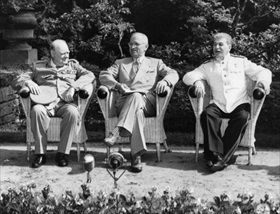 | 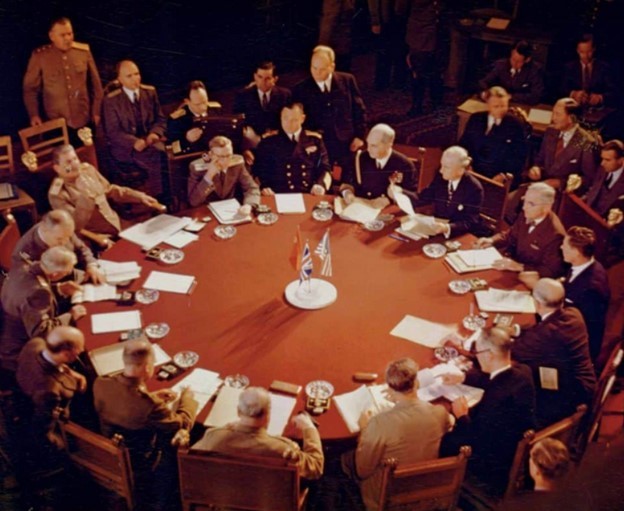 |
Left: Codenamed Terminal, the Potsdam Conference was the third Big Three conference between a U.S. President but the first between Harry S. Truman (seated center), British Prime Ministers Winston Churchill (to Truman’s right) and his postwar successor Clement Attlee (not seen), and Soviet Premier Joseph Stalin. The 17‑day conference got underway on July 17, 1945, in Berlin’s relatively undamaged, picture-postcard suburb of Potsdam and its eastern district of Babelsberg. It ended on August 2, 1945. The discussions were interrupted three-quartersway through as the heads of government awaited late returns of the July 5 British parliamentary elections. Churchill lost by a landslide and was replaced by his political opponent, Clement Attlee, who had been at the conference since its opening. The delegates resumed their negotiations on July 28. Chief among the agenda items pushed by the conferees was the establishment of a new postwar order in Central and Eastern Europe and in the Asia Pacific area that would rectify defects of the past three decades that followed the conclusion of the Versailles Conference in Paris (January 18, 1919 to January 21, 1920).
![]()
Right: Heads of government, foreign ministers, various advisers, and interpreters sit around the large oak table that dominated the conference room in Potsdam’s sprawling Cecilienhof Palace, named for Cecilia, the wife of Kaiser Wilhelm II’s son, Crown Prince Wilhelm. The photo was taken before Attlee (bald head lower left) succeeded Churchill (bottom left of center) as prime minister of Great Britain and head of government. Truman sits five chairs to the right of Churchill. At Stalin’s suggestion Truman was made conference chairman. It was on July 17, 1945, during the first of 13 plenary sessions, that Stalin announced his decision to declare war on Japan “with no strings attached,” as Truman later told his wife, Beth, in a letter home. On another occasion Truman bragged to his wife: “I can deal with Stalin . . . He’s honest but smart as hell.” Truman prophesied that with the Soviet Union in the fight against Japan “we’ll end the war a year sooner now, and think of the kids [i.e., U.S. servicemembers] who won’t be killed! That is the important thing.”
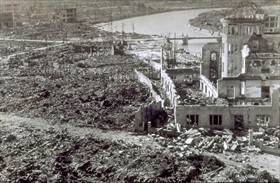 | 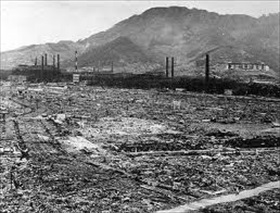 |
Left: The Hiroshima Chamber of Industry and Commerce Building was the only building remotely close to standing near the epicenter of the atomic bomb blast of August 6, 1945. Known today as the Genbaku (“Atom Bomb” in Japanese) Dome, it was left unrepaired by its citizens as a reminder of the unprecedented event that befell their city. It sits in a lush park, the Hiroshima Peace Memorial Park, surrounded by a metropolis of one million people. For many visitors the memorial park and museum are hallowed ground.
![]()
Right: The still-standing smokestacks of Nagasaki’s sprawling Mitsubishi Steel and Armament Works. The plant was located about 2,500 ft/762 meters downriver from ground zero. Nagasaki’s hilly terrain tempered the bomb’s destructive effects, whereas Hiroshima was flat and open and thus suffered much greater devastation. The horrific effect of the atomic bombings on two major Japanese cities, plus the threat posed by Soviet armies approaching the Chinese coast opposite the Japanese home islands, compelled Hirohito to order his country’s surrender.
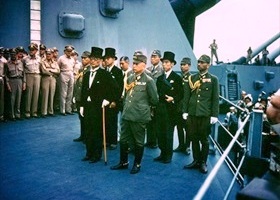 | 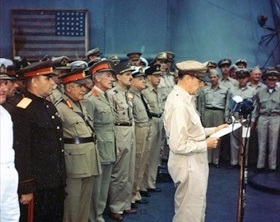 |
Left: The 11-member Japanese delegation of civilians and military officers shortly after their arrival on board the USS Missouri, Sunday, September 2, 1945. For the first time in its history Japan was surrendering to both a foreign power and an occupying power. Leading the delegation was Foreign Affairs Minister Mamoru Shigemitsu (top hat and cane). In 1948 Shigemitsu was sentenced to seven years imprisonment by the International Military Tribunal for the Far East. Paroled in 1950 Shigemitsu became Deputy Prime Minister of Japan in 1954.
![]()
Right: Dressed in khaki and an open-neck shirt, General of the Army Douglas MacArthur, Supreme Allied Commander, opened the 20‑minute surrender ceremony on the Missouri’s starboard veranda deck precisely at 9 a.m. Forty-three high-ranking officers from eight Allied powers lined up behind him. Slowly MacArthur intoned, “We are gathered here, representatives of the major warring powers, to conclude a solemn agreement whereby peace may be restored . . . It is my earnest hope and indeed the hope of all mankind that from this solemn occasion a better world shall emerge out of the blood and carnage of the past—a world founded upon faith and understanding, a world dedicated to the dignity of man and the fulfillment of his most cherished wish—for freedom, tolerance, and justice.”
Scenes of Postwar Berlin and Arrival of the “Big Three” in Potsdam
![]()

 History buffs, there is good news! The Daily Chronicles of World War II is now available as an ebook for $4.99 on Amazon.com. Containing a year’s worth of dated entries from this website, the ebook brings the story of this tumultuous era to life in a compelling, authoritative, and succinct manner. Featuring inventive navigation aids, the ebook enables readers to instantly move forward or backward by month and date to different dated entries. Simple and elegant! Click
History buffs, there is good news! The Daily Chronicles of World War II is now available as an ebook for $4.99 on Amazon.com. Containing a year’s worth of dated entries from this website, the ebook brings the story of this tumultuous era to life in a compelling, authoritative, and succinct manner. Featuring inventive navigation aids, the ebook enables readers to instantly move forward or backward by month and date to different dated entries. Simple and elegant! Click 











